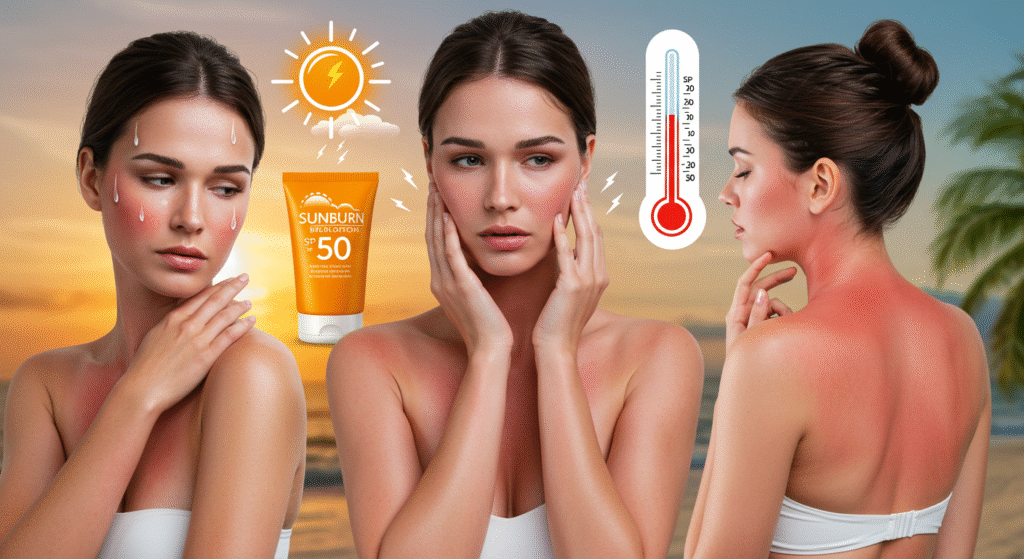If you’ve ever spent a little too much time in the sun, you know the sting of sunburn—that hot, red, and sometimes peeling skin that can ruin your beach day. Sunburn isn’t just uncomfortable—it’s your skin’s way of saying it’s been damaged by ultraviolet (UV) radiation.
Whether you’re a young adult, have fair skin, or spend hours outdoors, understanding how to prevent, treat, and recover from sunburn is crucial—not just for comfort but for long-term skin health.
In this complete guide, we’ll cover:
- What causes sunburn and why it happens
- How to heal a sunburn fast and prevent peeling
- Natural and medical remedies for relief
- Sunburn myths (like does a sunburn turn into a tan?)
- When to see a doctor (including signs of sun poisoning)
What Is Sunburn and Why Does It Happen?
Sunburn is an inflammatory reaction of the skin caused by overexposure to the sun’s UV rays (mainly UVB). It damages the DNA in skin cells, triggering redness, heat, pain, and swelling.
Key causes include:
- Staying outdoors without sun protection
- High UV index days (often between 10 a.m. and 4 p.m.)
- Being near reflective surfaces like water, sand, or snow
- Certain medications or skin care products that increase sun sensitivity
Symptoms of Sunburn
Sunburn symptoms can vary from mild to severe.
Mild sunburn:
- Pink or red skin
- Warm to the touch
- Mild discomfort or tightness
Moderate to severe sunburn:
- Intense redness and swelling
- Pain or burning sensation
- Blistering skin
- Chills, fever, or headache (possible sun poisoning)
- Nausea or dehydration
Can You Die From Sun Poisoning?
While sun poisoning itself isn’t typically fatal, it’s a severe form of sunburn that can lead to heatstroke, dehydration, or infection—all of which can be life-threatening if untreated.
Seek immediate medical attention if you have:
- Dizziness or fainting
- Severe blistering over large areas
- Persistent vomiting
- Fever over 102°F (38.9°C)
Does a Sunburn Turn Into a Tan?
One of the most common myths is that “sunburn turns into a tan.”
Here’s the truth:
- Tanning is your skin producing more melanin to protect itself.
- Sunburn is skin cell damage.
- Some redness may fade into a tan, but that’s not because the burn “became” a tan—it’s because damaged skin peels away, revealing slightly darker skin underneath.
Repeated burns increase skin cancer risk—so skipping sunscreen in hopes of a tan is dangerous.
How Long Does It Take to Get Tan?
Tanning time depends on:
- Your skin type (fair skin burns faster)
- UV index
- Duration of sun exposure
- Whether you’re using SPF protection
Some people notice tanning within a few hours, but safe tanning should be gradual, using SPF and limiting exposure.
How to Heal Sunburn Fast
When you notice redness or discomfort, act quickly:
1. Cool the skin
- Take a cool (not ice-cold) shower or bath.
- Apply a cool compress for 15–20 minutes.
2. Hydrate
- Drink extra water to replace moisture lost from the burn.
3. Moisturize
- Use aloe vera gel or a fragrance-free moisturizer.
- Avoid petroleum-based products during the first hours as they trap heat (but Aquaphor can be used later to lock in moisture).
4. Reduce inflammation
- Take ibuprofen or aspirin (if safe for you) to help with swelling and pain.
Can You Put Aquaphor on a Burn?
Yes—Aquaphor is generally safe for mild burns, including sunburn, once the heat has dissipated. Avoid applying it immediately after exposure, as it can trap heat. After 12–24 hours, it can help keep skin hydrated and reduce peeling.
Is Coconut Oil Good for Sunburn?
Coconut oil can be soothing after the initial heat phase (usually 24–48 hours later). Applying it too soon may trap heat and make symptoms worse.
Benefits after healing starts:
- Locks in moisture
- Reduces dryness and peeling
- Has mild antibacterial properties
But: It’s not a substitute for aloe vera or medical treatment in severe burns.
Does Coconut Oil Relieve Sunburn?
It can help once the skin cools, but aloe vera, oat baths, and cool compresses are more effective for the first stage.
How to Prevent Peeling From Sunburn
Peeling happens when your skin sheds damaged cells. While you can’t always stop it completely, you can minimize it:
- Keep skin moisturized (aloe + gentle creams)
- Avoid hot showers
- Drink plenty of water
- Don’t pick or peel skin manually
- Wear loose, breathable clothing
How to Keep Sunburn From Peeling
- Apply moisturizer multiple times a day
- Use coconut oil or Aquaphor during recovery phase
- Sleep in a cool, humid environment
Why Is My Sunburn Purple?
A purple or deep red sunburn could mean:
- Bruising under the skin
- More severe skin damage (possible second-degree burn)
- Sunburn on sensitive, thin skin areas
If it’s purple, blistered, or extremely painful—see a doctor immediately.
Is Witch Hazel Good for Sunburn?
Witch hazel has anti-inflammatory properties and can help reduce redness and irritation. Use alcohol-free witch hazel to avoid further drying the skin.
How to Heal Sunburned Eyes
Also called photokeratitis, this is like a sunburn on the cornea.
Treatment:
- Wear sunglasses to protect from further UV exposure
- Apply cool compresses to closed eyes
- Avoid rubbing your eyes
- Use artificial tears for dryness
- Seek medical attention if vision changes occur
Sunburn Prevention Tips
1. Use Sunscreen Correctly
- SPF 30 or higher
- Apply 15–30 minutes before going outside
- Reapply every 2 hours or after swimming/sweating
2. Wear Protective Clothing
- Wide-brim hats, sunglasses, and UPF-rated fabrics
3. Avoid Peak Sun Hours
- Stay in shade between 10 a.m. and 4 p.m.
4. Be Extra Cautious Near Water & Snow
- UV reflects off surfaces, increasing exposure
FAQs About Sunburn
Q1: Can a sunburn turn into a tan?
Sometimes the redness fades into a slightly darker tone, but that’s damaged skin—not a healthy tan.
Q2: Can I use coconut oil right away?
No, wait 24–48 hours until skin cools. Use aloe vera first.
Q3: Can you die from sun poisoning?
Not directly, but it can cause dangerous complications if untreated.
Q4: How long does a sunburn last?
Mild burns last 3–5 days, severe burns can take over a week.
Q5: Does peeling mean healing?
Yes—it’s your body shedding damaged cells, but protect the new skin underneath.
Final Thoughts: Protect Your Skin, Protect Your Future
Sunburn may seem like a temporary summer nuisance, but every burn increases your risk of skin cancer and premature aging.
By understanding prevention, fast treatment, and proper aftercare, you can enjoy the outdoors safely.
Your next step: Keep an SPF 30+ sunscreen in your bag, hydrate well, and listen to your skin—because healthy skin is beautiful skin.

